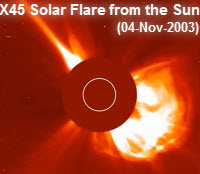 In mid-September WDAS Members hoped to see a display of the Northern Lights after a solar flare rated X1.6. But in April, NASA's 'Swift' Satellite witnessed a solar flare emitted from a young Red Dwarf star, estimated at X100,000. Could our sun do that? What would happen to an 'earth' orbiting that star?
In mid-September WDAS Members hoped to see a display of the Northern Lights after a solar flare rated X1.6. But in April, NASA's 'Swift' Satellite witnessed a solar flare emitted from a young Red Dwarf star, estimated at X100,000. Could our sun do that? What would happen to an 'earth' orbiting that star?
Solar flares are categorised by their strength from Class B, then C, M and the most powerful, Class X. The strongest solar flare recorded on the sun was an X45, and luckily the CME was not directed towards us.
The solar flare recorded by 'Swift' (a satellite designed to study gamma ray bursts in distant galaxies), came as quite a surprise to project scientists. It came from binary star system of two Red Dwarf stars named DG Canum Venaticorum (or DG CVn among friends). They are about a third of the sun's diameter and mass, and a-thousandth of its luminosity; and they orbit each other at about half the distance between the Sun and Jupiter (which is too close for NASA to know which of the pair erupted).
Could such a huge eruption happen to our sun?
It seems this is a behaviour of young stars, which rotate quickly, stirring up the magnetic fields which power solar flares. In its youth our sun may indeed have emitted superflares. At about 30 million years old DG CVn are cosmic infants. Fortunately for us, our sun no longer appears capable of doing this.
What would happen if the earth had been orbiting DG CNv?
Current estimates are that about 40% of Red Dwarfs have one or more earth-like planet, orbiting in the habitable zone of their star. Because Red Dwarfs are much cooler than our sun, the habitable zone is very close to the star - perhaps a tenth of the distance from the Sun to Mercury. Highly radioactive particles would rain like a monsoon or worse: it wouldn't be fun.
This is a superb video from NASA explaining about DG CNv's megaflare.
- Log in to post comments
